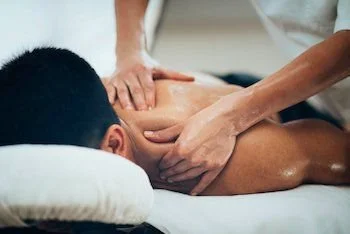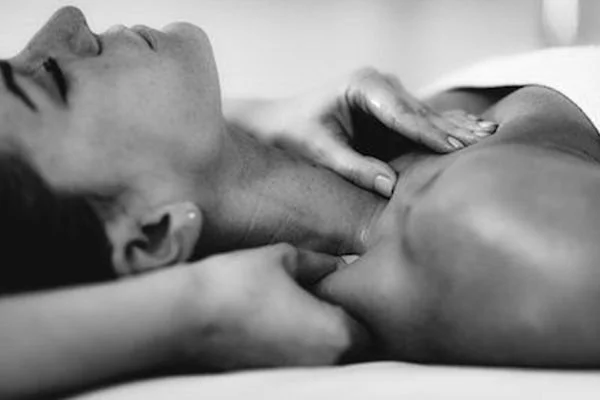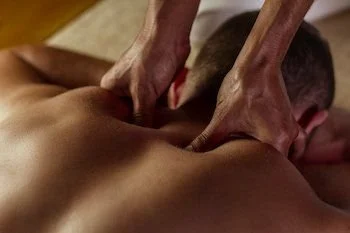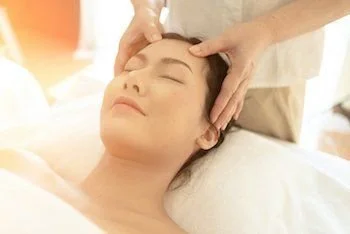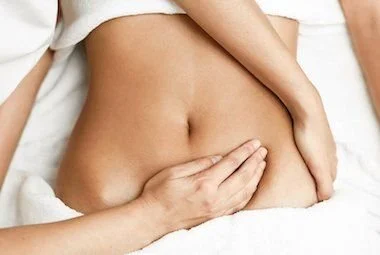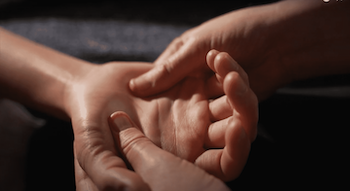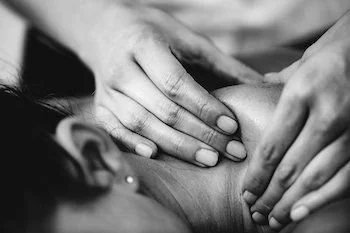Massage techniques: Which are best for you?
Summary: While massage techniques vary, they all work in the same way; they interact with the body, mind and nervous system in layers of context. What works best for you is really about personal preference. In this article we present current research findings on common massage techniques: Swedish massage, myofascial release, trigger point release, cranio-sacral therapy, visceral manipulation, sports massage, manual lymphatic drainage, deep tissue massage and scar tissue massage. To get the most out of your massage, choose the technique(s) you enjoy the most. (See below for all research references.)
How massage therapy works
In recent years, new information has come to light about how massage and manual therapy work. Before, it was believed that massage physically released tissues, trigger points and adhesions. Now, we understand that there are a series of complex interactions that contribute to why we feel great after a massage. These include:
affective touch
contextual factors
endogenous pain modulation
mechanical factors, and
neuroplasticity
We’re at an exciting turning point where new knowledge is available to us. We now understand that it's not about one technique being the best, but there are a series of complex interactions that contribute to treatment outcomes. This means that the best massage therapy techniques for you are the ones that feel good for you, in an environment where you can relax and with an RMT you trust.
While the explanation for how massage therapy works has changed, it takes time to integrate new models of understanding into board exams, school curriculum, clinical practice and continuing education. We hope this article serves to capture a snapshot summary of the original theories of various massage techniques and how we now understand all techniques to work through the same mechanisms of action.
Massage techniques and current research findings
Note: Some massage therapy techniques have outdated names and theories behind them but using those names can be a way to communicate the style of massage you enjoy. Let’s explore these nine massage techniques or terms together:
Swedish massage
Myofascial release
Trigger point release
Cranio-sacral therapy
Visceral manipulation
Sports massage
Manual lymphatic drainage
Deep tissue massage
Scar tissue massage
[Please note: Massage therapy schools in Vancouver do not teach Shiatsu massage, reflexology or acupressure massage. The College of Registered Massage Therapists does not allow RMTs to perform ashiatsu or barefoot massages (CMTBC, 2021).]
Swedish Massage
The term Swedish massage was formalized in the 19th century (AMTA, 2015), and is a massage done with oil, lotion or gel. It commonly involves rhythmic kneading using the hands, forearms and fingers. The pressure can be light, medium or firm, depending on your preference. Typically, Swedish massage is a relaxing style of massage that can be helpful for stress, anxiety, pregnancy, injuries, headaches, insomnia and other conditions that benefit from calming the nervous system. Note: Many cultures use massage with oil as part of their healing traditions.
2. Myofascial release
Fascia is a web of connective tissues that holds our body together; it wraps around muscles, organs and tendons. In the early 1990s, the Fascial Distortion Model (FDM) was created. It proposed that all musculoskeletal complaints could be traced back to three-dimensional deformations or distortions of the fasciae and that these distortions could be corrected by applying specific manual techniques (Typaldos, 1994). More recently, studies have concluded that we can’t release fascia with the force of our human hands (Chaudhry, 2008).
“A literature review found no clinical trials or basic research studies to support the empirical foundations of the FDM contentions” (Thalhamer, 2018). So why did we start calling it myofascial release? As Vancouver-based science writer Paul Ingraham puts it, it was an idea that went viral with business models claiming to melt and blast fascia despite a lack of evidence (Ingraham, 2021).
Whether you enjoy massage without oil (or with oil), it can result in real benefits like increased relaxation response or decreased pain (just not the actual release of fascia). Curious to learn more? Read more about the science of fascia here.
3. Trigger point release
By now you may be asking, what are trigger points and are they actually being released? Travell’s theory of trigger points, published in the 1950s, stated that sore spots in muscles are metabolically congested tissues with less blood supply. Recommended treatment involved applying sustained pressure in these sore spots and slowly easing off as discomfort subsided; the area was then iced and stretched. Trigger point needling or injections were also suggested treatment options (administered by other professionals).
One study concluded that experts cannot reliably or consistently find trigger points through touch (Rathbone, 2017). Doctor John Quinter concludes there is no scientific evidence for trigger points as entities or the cycles that were believed to perpetuate them (Quintner, 2015). We know that we get sore spots—we just don’t know exactly what they are or the best way to treat them.
Some people prefer sustained pressure into a sore spot, while others may find this irritates the area. Using the phrase trigger point release can still be a way to communicate the style of massage you do (or don’t) like.
4. Cranio-sacral therapy
Until recently, cranio-sacral therapy (CST) was taught in Vancouver massage therapy schools. The original theory believed that restrictions and misalignments of the bones of the skull and sacrum—and tension of the intracranial meninges—directly impact one’s health and wellbeing. Proponents of the theory thought these issues could be assessed, diagnosed and treated with CST, which would normalize suture movement and intracranial rhythm (Upledger, 1983).
The journal article Craniosacral Therapy and Professional Responsibility concluded otherwise:
“Despite more than 50 years of investigation and the promotion of CST [...] there remains a void in credible evidence supporting the ability of these techniques to alter the movement of the cranial sutures or improve patient-centered outcomes. [...] It is also imperative that physical therapy professionals who perform cranial techniques do not communicate to patients disproved concepts of moving cranial sutures or balancing cranial rhythms. This language is disingenuous and may lead to creating disability in our patients by providing the perception that there is some sort of structural deformity in their body and implying that they are ill” (Flynn, 2006).
Now we know that the potential benefit of this approach isn’t from cranial sutures moving or cerebrospinal fluid rhythms being restored. Still, you may enjoy receiving this type of massage as a part of your treatment because it can be deeply relaxing; when an RMT tunes in and holds your head with slow and intentional touch, it can feel calming and restorative. Cranio-sacral techniques can be helpful for people who respond well to a slower style of treatment, or find other types of manual therapy to be too stimulating.
5. Visceral manipulation
In the 1980s, French osteopath Jacques Weischenck introduced the concept of visceral osteopathy (Weinschenk,1982). The theory proposed that our organs have natural movement patterns that can go out of balance and cause or contribute to pain or gastrointestinal issues (like irritable bowel disorders); and that these mobility or motility restrictions can be detected by touch and treated by manipulation (Barral, 2004).
In 2018, the paper Reliability of Diagnosis and Clinical Efficacy of Visceral Osteopathy: A Systematic Review examined the reliability of the diagnostic techniques and the clinical efficacy of techniques used in visceral osteopathy. It concluded: “As a whole, this systematic review shows that currently, there is no evidence for the reliability or specific efficacy of the techniques used in visceral osteopathy” (Guillaud, 2018).
Teaching visceral osteopathy techniques has been banned in some countries, including France (2007); however, courses are still offered for Registered Massage Therapists in Canada. There can be benefits to having your abdominal area massaged, especially if you’re experiencing stress, low back pain or digestive concerns. But we now understand that we aren’t detecting or fixing problems with organ movement patterns.
6. Sports massage
Registered Massage Therapists who offer sports massage don't necessarily have a special technique; rather they’re familiar with the physical requirements of your sport, the injuries that can occur and what precautions to take according to where you’re at in your training cycle. They could also communicate and coordinate care with your coach or other members of your team upon your request.
There are different approaches for pre-game and post-game massages:
A pre-sporting event massage is more activating; it involves jostling of larger muscle groups while avoiding intense or painful work that could impact your performance
A post-sporting event massage is often done in a relaxing style to help you wind down after your big event
A recent systematic-review and meta-analysis of sports massage research concluded that sports massage doesn’t improve performance. Instead, it induces a small but significant improvement in flexibility and reduces/prevents delayed onset muscle soreness (DOMS) (Davis, 2020).
7. Manual lymphatic drainage
Many Vancouver-based massage therapy schools include an introduction to Manual Lymphatic Drainage (MLD), with the option to take additional training as an RMT. MLD involves applying light circular motions on the skin and potentially applying compression bandages after treatment, with the goal of decreasing swelling after injury or surgery. As a gentle, rhythmic technique it can also be enjoyable for those who simply prefer a gentler treatment style.
A meta-analysis of MLD techniques (MLDT) concludes that there may be some benefits and that more research is needed to establish clinical practice guidelines:
“The best evidence suggests that efficacy of MLDT in sports medicine and rehabilitation is specific to resolution of enzyme serum levels associated with acute skeletal muscle cell damage as well as reduction of edema following acute ankle joint sprain and radial wrist fracture. [...] Manual lymphatic drainage techniques remain a clinical art founded upon hypotheses, theory, and preliminary evidence. Researchers must strive to clarify the biophysical effects that underpin its various proposed therapeutic applications in the human organism. Randomized controlled trials and longitudinal prospective cohort studies are required to establish the efficacy of MLDTs in producing positive outcomes for patients rehabilitating from sports-related injuries.” (Vairo, 2009).
You might try Manual Lymph Drainage after an injury or surgery to see if it helps decrease swelling or discomfort for you.
Unfortunately Manual Lymph Drainage is sometimes advertised as a ‘double-chin reduction treatment’ or ‘cellulite reducing treatment’. These claims are not evidence-based and the treatments are often much more expensive.
(It’s interesting to know that muscle contractions and breathing help move lymph around, so your favourite form of movement or exercise may accomplish more systemic movement of lymph.)
8. Deep tissue massage
Deep tissue massage is not a technique that is taught in Vancouver massage therapy schools but we’ve included it here because it’s a commonly used massage term—a subjective one—that means different things to different people. Commonly, it conveys an individual preference for firm pressure during a massage.
Pressure preferences vary amongst individuals, different body areas and can even change from day to day. Clear communication with your RMT can help determine what type of pressure feels best for you and in which areas. Check out our blog post, “What is Deep Tissue Massage?” for a more in-depth discussion on this topic.
9. Scar tissue massage
Massage therapy doesn’t break up scar tissue or release adhesions, yet there can be other meaningful benefits experienced. To learn more, read our blog post on Scar Tissue Management and Massage Therapy.
Considering that all massage techniques work through the same mechanisms of action, the best massage therapy techniques for you are the ones you enjoy and that you experience the most benefit from.
Find an RMT who excels in the techniques you enjoy most, in an environment you feel comfortable in. An RMT with great communication skills can help you explore what works best for you and provide insightful evidence-based explanations for how massage works!



